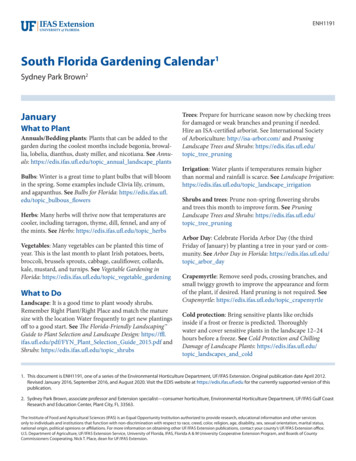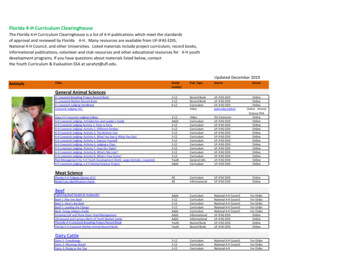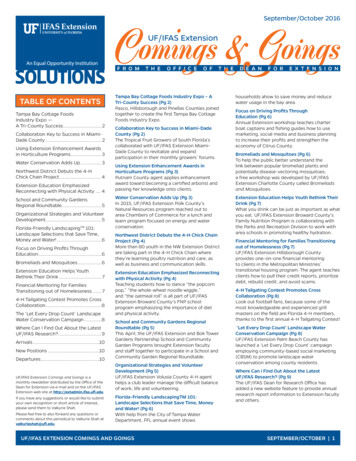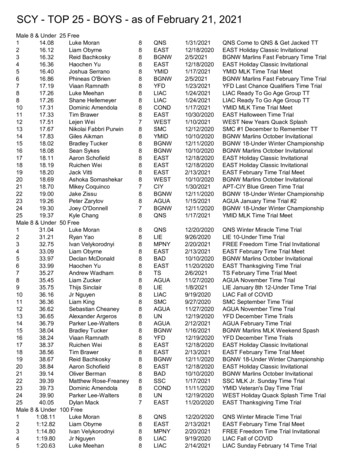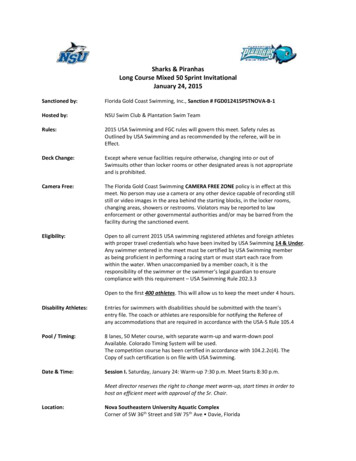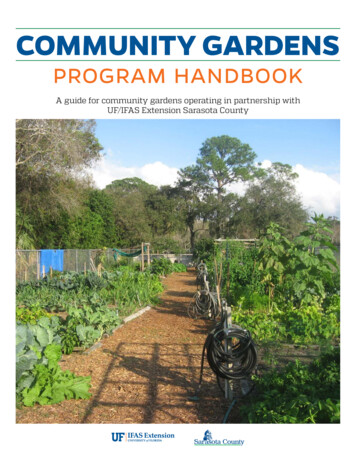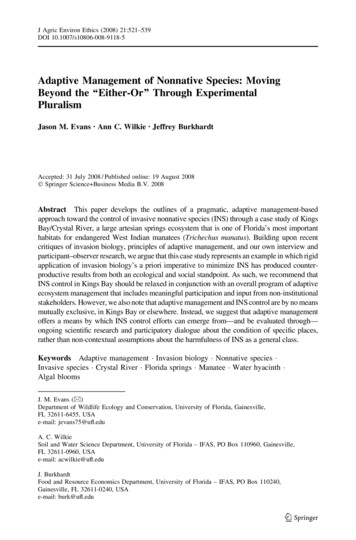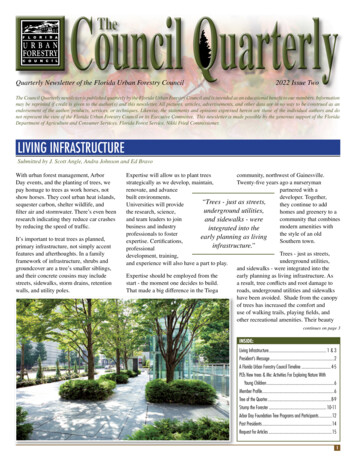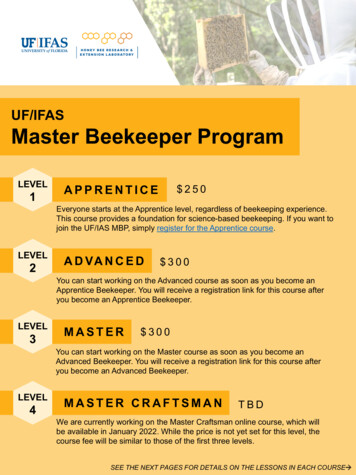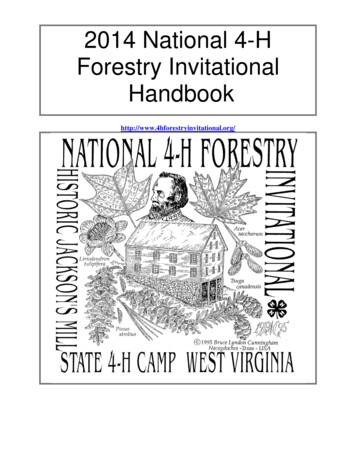
Transcription
2014 National 4-HForestry nal.org/
The 2014 National 4-H Forestry Invitational is sponsored by:Farm Credit SystemPlum CreekSustainable Forestry InitiativeSociety of American ForestersWest Virginia UniversityAssociation of Natural Resource Extension ProfessionalsAmerican Forest FoundationNational Woodland Owners Association
NATIONAL 4-H FORESTRY INVITATIONAL HANDBOOKCONTENTSPageIntroduction . 1Objectives . 2General Rules and Regulations . 3Tree Identification . 5Forest Health -- Insects . 9Forest Health -- Diseases and Health Indicators . 12Tree Measurement . 14Compass and Pacing . 19Topographic Map Contest . 22Forestry Bowl . 25Forest Evaluation . 31Forestry Written Examination . 40Scoring Method for Individual and Team Competition . 40Forest Understandings and Facts . 41Glossary . 44A Summary of Federal Laws Affecting Forestry . 48References . 50This handbook was originally prepared by the National 4-H Forestry Invitational Committee for an experimentalevent first conducted at the State 4-H Camp, Jackson's Mill, West Virginia, July 1980.Thirty-third Edition, February 6, 2014Original Editor, Dr. Frank Roth, now Retired Forester, Arkansas Forestry CommissionAs a program of the U.S. Department of Agriculture (USDA), the National 4-H Forestry Invitational prohibits discrimination in allits programs and activities on the basis of race, color, national origin, age, disability, and where applicable, sex, marital status,familial status, parental status, religion, sexual orientation, genetic information, political beliefs, reprisal, or because all or part ofan individual's income is derived from any public assistance program. The Invitational encourages persons with disabilities toparticipate in its programs and activities. Persons with disabilities anticipating needing any type of alternative accommodations orfor questions about physical access provided.http://www.4hforestryinvitational.org/i
NATIONAL 4-H FORESTRY INVITATIONAL MANAGEMENT COMMITTEEDave ApsleyOhio State University Extension17 Standpipe RoadJackson, OH 45640-9268(740)286-5044 ext. 30FAX (740)286-1578apsley.1@osu.eduSunshine BrosiAssistant ProfessorFrostburg State University205 Compton Science CenterFrostburg, MD 21532-2303(301)687-4213slbrosi@frostburg.eduLinda CarnellWest Virginia Forestry Division1 Depot StreetRomney, WV 26757-1400(304)822-4512FAX (804)822-7331Linda.O.Carnell@wv.govTodd DaileyTodd DaileyFarm Credit of Florida5075 NW Blitchton RoadOcala, FL 34482(352) 622-4188(800) 342-3795TDailey@FarmCreditFL.comAmy Fannon-OsbournExtension AgentVirginia Cooperative ExtensionP. O. Box 1156Wise, Virginia 24293-1156(276) 328-6194FAX (276)328-5902afannon@vt.eduTommy & Susan FutralFutral Outdoors11260 Pearson Chapel Rd.Goodwater, AL 35072(256)794-1869futraloutdoors@yahoo.comBob HansenPenn State Extension701 South Fourth StreetTowanda, PA 18848(570)265-2896FAX (570)265-4371rsh7@psu.eduWilliam HubbardSouthern Regional ExtensionForesterThe University of Georgia4-402 Forest Resources BuildingAthens, GA 30602(706)542-7813Fax: (706)542-5070whubbard@uga.eduDavid Jackson, ChairmanForest Resources EducatorPenn State Extension420 Holmes AvenueWillowbank Building, Room 322Bellefonte, PA 16823-1488(814)355-4897FAX (814)355-6983drj11@psu.eduRick TurcotteForest EntomologistUSDA Forest Service180 Canfield StreetMorgantown, WV 26505(304)285-1505FAX (304)285-1505rturcotte@fs.fed.usBill WorrellNatural Resources ExtensionAgentVirginia Cooperative Extension113 E. Main StreetLebanon, VA 24266(276)889-8056bworrell@vt.eduDanielle MartinForest PathologistState and Private ForestryUSDA Forest ServiceMorgantown, WV 26505-3180(304)285-1531dkmartin@fs.fed.usFOR REFERENCE:Jackson’s Mill 4-H Conf. CenterWeston, WV 264521-800-287-8206(304)269-5100FAX (304)269-3409Jacksons.Mill@mail.wvu.eduDavid McGill, Co-chairmanWVU Extension Service/AHCP.O. Box 6125Morgantown, WV 26505-6125(304)293-2941 ext. 2474FAX (304)293-2441dmcgill@wvu.eduCarol BeneshNational Program LeaderDivision of Youth and 4-HUSDA, National Institute of Foodand Agriculture (NIFA)4405 Waterfront Centre800 9th St., SW,Washington, DC 20024(202)401-6861FAX (202)720-9366cbenesh@nifa.usda.govBarb McWhorterStaff ForesterUSDA-NRCS1550 Earl Core Road, Suite 200Morgantown, WV 26505(304)284-7576FAX (304)284-4839Barbara.McWhorter@wv.usda.govSheldon OwenWildlife Extension SpecialistWest Virginia University329D Percival HallPO Box 6125Morgantown, WV 26506(304)293-2990Sheldon.Owen@mail.wvu.edu1Dr. Eric NorlandNational Program LeaderDivision of EnvironmentalSystemsUSDA, National Institute of Foodand Agriculture (NIFA)3212 Waterfront Centre800 9th St., SW,Washington, DC 20024(202)401-5971FAX (202)401-1706enorland@nifa.usda.gov
(Changes for 2014 are in red. See page 22)INTRODUCTIONThe National 4-H Forestry Invitational is the National Championship of 4-H Forestry. Eachyear, since 1980, teams of 4-H Foresters from many different states come to Jackson's Mill State 4-HCamp near Weston, West Virginia, to meet, compete and have fun. During two days of competition4-H Foresters participate in forestry skills and knowledge events including:1. Tree Identification2. Tree Measurements3. Compass and Pacing4. Topographic Map Contest5. Forestry Bowl6. Forest Evaluation7. Insect Identification8. Disease Identification9. Forestry Written ExaminationIn addition the Invitational includes recreational activities such as local tours, campfires andlumberjack skills events. Although competitive in nature, the Invitational is managed as an extensiveforestry educational experience. It provides an opportunity for exploration of the broad aspects offorestry. The setting, contests, leadership, and supplementary events are all directed to this end.The event is organized and managed by a national steering committee consisting of ExtensionService forestry professionals, county Extension educators, US Forest Service professionals, forestryindustry representatives, state forestry agency professionals and other university faculty.Team DevelopmentThere is no standardized national system for team development or the selection of teams toattend the National 4-H Forestry Invitational. Individual state 4-H forestry programs are too diverse forsuch standardization. Ideally, there should be county, regional, and state competitions with the winnerscompeting on the national level. Realistically, however, team development must be according to instate structures and resources. We recommend that a system be established in each state for potentialteam members to become thoroughly familiar with the Invitational events. This might be at regional orstate 4-H forestry camps, or as a special addition to more general natural resources camps. ThisHandbook is intended as a rule book for the National 4-H Forestry Invitational and as a guide for teamdevelopment. Please ask forestry professionals to assist with team training, and use other educationalmaterials to broaden the 4-H member's understanding of forestry. Such an understanding is essential tosuccess in the Invitational, and to the successful management of our nation's forest resources in thefuture.1
OBJECTIVESThe objectives of the National 4-H Forestry Invitational are to provide the opportunity andatmosphere for 4-H members from all states to:1. develop leadership talents and to work toward achieving character development and effectivecitizenship;2. develop an appreciation of the importance of conserving forests as a sources of income, rawmaterials, and enjoyment necessary for quality living; and3. acquire information and understanding of practical forestry skills in forest management and the useof forest and wood products.In addition to meeting these objectives, the event encourages and promotes increasedknowledge of forests and forestry by 4-H members, volunteer leaders, and Extension agents at local,county, district, state, and national levels. Although they may never be forest landowners, as futureadults, 4-H members will learn to weigh and understand renewable resource management needs.Preparation of youth in this event: (1) presents, identifies, and locates the renewable resources of theforest environment such as forest products, water, outdoor recreation, wildlife, and selected grazing;(2) establishes a natural resource value system for participating 4-H members; (3) helps 4-Hlandowners understand the techniques of managing their land and improving the understanding of 4H'ers as potential landowners; and (4) furnishes facts and scientific procedures for future landowners,administrators, and planners who are not professional land managers.The Competitive Team Approach, which is used in the National 4-H Forestry Invitational,develops at all levels the following benefits: (1) Intensified learning opportunities using correctmanagement information and factors concerning forest resources; (2) Standardizes, or presents, similarreferences, materials, guides, and understanding on tree identification, forest measurements, and use ofsilvicultural problems of management, insects, diseases, etc.; (3) Encourages rural, suburban, andurban teens to share ideas and visit potential management areas with a new perspective of 4-H forestry;(4) Provides new insight to senior members who serve as teen leaders with younger 4-H members inbeginning forestry projects; (5) Allows teen members to formulate goals and discuss managementprocedures with other 4-H'ers and with professional land managers; and (6) Provides a new dimensionfor older 4-H member activities and incentives for younger members beyond the present projectoriented program.2
GENERAL RULES AND REGULATIONSThis event will comply with all "Policies and Guidelines for National 4-H Competitive Events"as approved by USDA Extension Service, 1990.Contestants and Eligibility1. Each state is allowed to enter only one team or up to two individual contestants. A team will consistof no less than three and no more than four official entrants who are 4-H members in their stateduring the current year. If a state is unable to muster a team, it may send up to two contestants tocompete in the individual events only.2. All contestants must have passed their 14th birthday on or before December 31 of the precedingyear, and must not have passed their 19th birthday on January 1 of the contest year.3. An individual may enter the National 4-H Forestry Invitational event only once.4. The team of contestants must be certified as the official state entry by the State Extension Directoror by a person designated by the Director. The individuals or team may be selected by any procedurewhich a state considers appropriate.5. Contestants in the National 4-H Forestry Invitational must not have participated in official postsecondary (university, college, junior college, or technical school) competitive events of a similarnature in the same subject matter area. Neither can he/she be a member of a post secondary teamundergoing training in preparation for an event. (For example, a contestant who has competed in anofficial collegiate forestry contest, either on or off campus, is ineligible to compete.) The State 4-HProgram Leaders are responsible for determining the eligibility for participants in National 4-HCompetitive Events from their respective States.6. All states participating in the Invitational must provide a signed statement from the State 4-H Officeverifying that the team has insurance coverage while traveling and attending the Invitational.General Contest Rules1. State team entries must be submitted on an official entry blank, by the specified due date.2. Each team shall have no more than one head coach and two assistant coaches. Current 4-H membersmay serve as coaches for the team, but those individuals will be ineligible as future contestants.3. Adult representatives from states not competing in the current Invitational are welcome to observe.They may be asked to assist in the Invitational administration.4. Only contestants and designated officials shall be within the perimeter of an event other than certainparts of the Forestry Bowl. Once a contestant has started an event, he/she will not be allowed to talkwith anyone other than a designated official until completion of that particular event, except incertain team events.3
5. A team may be composed of either three or four members. A team captain will be selected by eachstate for the Invitational contest. Team scores will be based on the three highest scoring teammembers in each individual contest area. Individual contestants will compete for highscoring individual honors.6. There are certain activities at the Invitational for which attendance is required. If a team or teammember (including the coach) is absent from a required activity, all points earned during that day’scompetition will be forfeited. If the attendance policy is abused prior to the start of competition, allpoints for the first day of competition will be forfeited.7. Each contestant will bring a clip board or writing board, pencil, and calculator. Binoculars and handlenses are permitted for use during contest events. Contestants are encouraged to wear field clothingand heavy shoes. Raingear is highly recommended.8. No image or audio recording device such as cell phones, I-pods, still cameras, video cameras, moviecameras, or tape recorders will be permitted during competitive events listed in paragraph 1 ofIntroduction on page 1. No Invitational participant (4-H team member, coach or adult chaperone) isallowed to write down or record any questions asked during Forestry Bowl competitions or fromwritten exam.9. The use of alcoholic, tobacco or other controlled substances will NOT be allowed. Rules of the 4-Hcamp will be enforced.10. After the Invitational, individual and team scores will be distributed to the team coach. Contestscore sheets will not be distributed.11. A hard hat will be provided for all 4-H team members, coaches and adult chaperones. Each statedelegation will provide its own safety glasses or glasses. Hard hats and safety glasses must beworn when a team member, coach or adult chaperone enters a woodland area. Failure to complywith this policy will eliminate the team from competition.12. Any Invitational participant (4-H team member, coach or adult chaperone) who participates in anyof the forestry skills events will be required to wear the personal protection equipment supplied bythe Invitational for that event. Closed-toed shoes will be worn by all participants in the forestryskills events. Sandals or other open-toed shoes will not be worn during participation in any of theforestry skills events.Appeals Procedure1. The National 4-H Forestry Invitational contest is, primarily, an educational program and fewproblems should be associated with the competition. However, realizing that the pressure to win ishuman nature, the Appeals Procedure, as stated in the ECOP Policies and Guidelines for National 4H Competitive Events will be used.2. The Invitational Management Committee will serve as the Appeals Committee and reviewrecommendations for operational and procedural changes. Appeals must be filed by the Invitationalteam captain with the Invitational Chairman within 30 minutes of the end of the day's scheduledcontest events and before supper of that day. Forestry Bowl appeals will be handled according toBowl rules as stated in "Procedures for Protest," page 28.4
TREE IDENTIFICATIONObjectiveContestants will learn to recognize and identify different tree species. This skill is valuablebecause tree species have varying requirements for growth, and differ in use and value.Contest Rules1. Each contestant will have the opportunity to identify 25 trees as found in a natural outdoorcondition or from branches or other parts displayed, and 25 herbarium specimens of trees foundin sections of the United States other than the Invitational site. All trees to be identified will betaken from the "official tree list" below.2. Contestants will be judged on the accuracy of identification and the spelling of common names.Scientific names will not be required. Incomplete names, such as maple instead of red maple orshortleaf instead of shortleaf pine, will be considered incorrect. Spelling, includingcapitalization, must be the same as that on the Official Tree List in order to becounted correct.3. Contestants will be given a specific time to identify the tree specimens and record theinformation on the score sheet.4. Two points will be given for the correct common name. One-half point will be deducted foreach name misspelled. Common names must be those used in the "official tree list." Maximumscore for this event is 100 points.OFFICIAL TREE LISTCommon NameScientific NameGymnosperms (Softwoods)Dicotyledonsbalsam firwhite firnoble firincense-cedarRocky Mountain junipereastern redcedartamarack or eastern larchwhite spruceblue sprucered spruceSitka sprucelodgepole pineshortleaf pinepinyon pinesugar pineAbies balsamea Mill.Abies concolor Lindl.Abies procera Rehd.Calocedrus decurrens Torr.Juniperus scopulorum Sarg.Juniperus virginiana L.Larix laricina K. Kock.Picea glauca VossPicea pungens Engelm.Picea rubens Sarg.Picea sitchensis Carr.Pinus contorta Dougl.Pinus echinata Mill.Pinus edulis Engelm.Pinus lambertiana Dougl.5
longleaf pineponderosa pinered pinepitch pineeastern white pineloblolly pineVirginia pineDouglas-firgiant sequoiaredwoodbaldcypress or bald cypressPacific yewnorthern white-cedar or arborvitaewestern redcedareastern hemlockwestern hemlockPinus palustris Mill.Pinus ponderosa Dougl.Pinus resinosa Ait.Pinus rigida Mill.Pinus strobus L.Pinus taeda L.Pinus virginiana Mill.Pseudotsuga menziesii FrancoSequoia giganteum Lindl.Sequoia sempervirens Lindl.Taxodium distichum Rich.Taxus brevifoliaThuja occidentalis L.Thuja plicata Donn.Tsuga canadensis Carr.Tsuga heterophylla Raf.Angiosperms (Broadleaf Trees or Hardwoods)DicotyledonsboxelderNorway maple (exotic invasive)red maplesilver maplesugar mapleyellow buckeyetree-of-heaven (exotic invasive)red alderyellow birchsweet birch or black birchpaper birchriver birchpignut hickorypecanshagbark hickorymockernut hickoryhackberryflowering dogwoodcommon persimmon or persimmonAmerican beechwhite ashhoneylocustAmerican hollybutternut or white walnutblack walnutsweetgumyellow-poplar or tuliptree or tulip-poplarcucumbertree or cucumber magnoliasouthern magnoliaAcer negundo L.Acer platanoides L.Acer rubrum L.Acer saccharinum L.Acer saccharum Marsh.Aesculus flava Ait.Ailanthus altissima (Mill.)SwingleAlnus rubra Bong.Betula alleghaniensis BrittonBetula lenta L.Betula papyrifera Marsh.Betula nigra L.Carya glabra SweetCarya illinoinensis K. Koch.Carya ovata K. Koch.Carya alba Nutt.Celtis occidentalis L.Cornus florida L.Diospyros virginiana L.Fagus grandifolia Ehrh.Fraxinus americana L.Gleditsia triacanthos L.Ilex opaca Ait.Juglans cinerea L.Juglans nigra L.Liquidambar styraciflua L.Liriodendron tulipifera L.Magnolia acuminata L.Magnolia grandiflora L.6
red mulberryblack tupelo or blackgumroyal paulownia (exotic invasive)sycamore or American sycamoreeastern cottonwoodquaking aspenblack cherrywhite oakscarlet oaksouthern red oakwater oakbur oaknorthern red oakblack oaklive oakblack locustblack willowsassafrasAmerican basswoodAmerican elmMorus rubra L.Nyssa sylvatica Marsh.Paulownia tomentosa (Thunb.) Steud.)Platanus occidentalis L.Populus deltoides Bartr.Populus tremuloides Michx.Prunus serotina Ehrh.Quercus alba L.Quercus coccinea Muenchh.Quercus falcata Michx.Quercus nigra L.Quercus macrocarpa Michx.Quercus rubra L.Quercus velutina Lam.Quercus virginiana Mill.Robinia pseudoacacia L.Salix nigra Marsh.Sassafras albidum Nees.Tilia americana L.Ulmus americana L.Monocotyledonscabbage palmetto or cabbage palmSabal palmetto Walt.This list was cross-referenced and checked for preferred common names, spellings, and scientificnames. The following reference was used as the official source for common names, scientific namesand spelling:Little, Elbert L. 1978. Important Trees of the United States. USDA Ag. Handbook 519, 70 pp.TREE IDENTIFICATION WEB SITEThe Virginia Tech Dendrology web site is a suggested reference for training teams for the TreeIdentification Contest. This web site can be accessed from the “Training References” section of theInvitational web site. Individual species listed on the Invitational’s Tree Identification web pagesare linked to the Virginia Tech Dendrology web site. Other tree identification web sites are listedfor additional help in training.7
TREE IDENTIFICATION SCORE SHEETStateGroup No.Contestant's NameCommon NameNo.Correct 2425Contestant's Score8Score
FOREST HEALTH – INSECTSObjectiveContestants will learn to recognize and identify forest insects or evidence of insectdamage. This is a valuable skill because most insects that damage tree affect only certain treespecies or groups of related species. Insect epidemics can cause high dollar value damage in theforests.Contest Rules1. Contestants will be required to identify 10 insects or examples of their damage.Specimens will be selected from those on the “Official List of Insects” (page 10).2. Contestants will be judged on the accuracy of identification and the spelling of thecommon names. Scientific names will not be required. Incomplete names such ascaterpillar instead of eastern tent caterpillar will be considered incorrect. Spelling,including capitalization, must be the same as that on the Official List ofInsects in order to be counted correct.3. Contestants will be given a specific time to identify the insect or insect damagespecimens.4. Five points will be given for each correct common name. One point will be deductedfor each name misspelled. The common name must be the one used in the "OfficialList of Insects."Official Reference for Insects and DiseasesThe official reference for the Insect and Disease Identification Contests is the web sitelink for each insect or disease species listed on the Insect and Disease Identification web pagesunder the “Training References” section of the Invitational web site.Additional Reference for Insects and DiseasesThe two references listed below are additional references that may be helpful in training for theInsect and Disease Identification contests. However, they are not “Official” references for theInsect and Disease Identification contests.Insects That Feed on Trees and Shrubs, by Warren T. Johnson and Howard H. Lyon. 1976.Cornell University Press, Sage House, 512 East State St., Ithaca, New York 14850.Diseases of Trees and Shrubs, by Wayne A. Sinclair, Howard H. Lyon and Warren T. Johnson.1987. Cornell University Press, Sage House, 512 East State St., Ithaca, New York 14850.Insect and Disease Web SitesThe Invitational web site provides links to other insect and disease identification websites as additional training reference aids. These other web sites are not “Official References” forthe contest.9
OFFICIAL LIST OF INSECTSCommon NameScientific NameAsian longhorned beetlebalsam woolly adelgidbeech scalebronze birch borercaterpillar hunter beetlecheckered beetleDouglas-fir tussock motheastern tent caterpillaremerald ash borerEuropean pine sawflyfall webwormforest tent caterpillargypsy mothhemlock woolly adelgidIps engraver beetlesJapanese beetlelocust borerlocust leafminermountain pine beetleNantucket pine tip mothpales weevilperiodical cicadapine needle scalered oak borerredheaded pine sawflysmaller European elm bark beetlesouthern pine beetletwolined chestnut borerwhite pine weevilwhitemarked tussock mothAnoplophora glabripennis (Motschulsky)Adelges piciae (Ratzeburg)Cryptococcus fagisuga (Lindinger)Agrilus anxius (Gory)Calosoma sycophanta (Linnaeus)Thanasimus dubius (Fabricius)Orgyia pseudotsugata (McDunnough)Malacosoma americanum (Fabricius)Agrilus planipennis (Fairmaire)Neodiprion sertifer (Geoffroy)Hyphantria cunea (Drury)Malacosoma disstria (Hubner)Lymantria dispar (Linnaeus)Adelges tsugae (Annand)Ips spp.Popillia japonica (Newman)Megacyllene robiniae (Forster)Odontota dorsalis (Thunberg)Dendroctonus ponderosae (Hopkins)Rhyacionia frustrana (Comstock)Hylobius pales (Herbst)Magicicada septendecim (Linnaeus)Chionaspis pinifoliae (Fitch)Enaphalodes rufulus (Halderman)Neodiprion lecontei (Fitch)Scolytus multistriatus (Marsham)Dendroctonus frontalis (Zimmermann)Agrilus bilineatus (Weber)Pissodes strobi (Peck)Orgyia leucostigma (J.E.Smith)10
FOREST HEALTH -- INSECTS SCORE SHEETStateNo.Group NumberContestant’s NameCorrect 5Misspelled -1Common Name12345678910Contestant's Score11Score
FOREST HEALTH -- DISEASES AND HEALTH INDICATORSObjectiveContestants will learn to identify forest diseases and other forest health indicators. This is a valuableskill because most diseases that damage trees affect only certain tree species or groups of relatedspecies. Diseases can cause high dollar value damage in the forests. Not all indicators of foresthealth are diseases Specimens will be selected and displayed which are representative of diseasesand damage.Contest Rules1. Contestants will be required to identify 10 diseases, specimens of disease damage or other foresthealth indicators. Specimens will be selected from those on the "Official List of Diseases andForest Health Indicators."2. Contestants will be judged on the accuracy of identification and the spelling of the commonnames. Scientific names will not be required. Incomplete names will be considered incorrect.Spelling, including capitalization, must be the same as that on the Official Listin order to be counted correct.3. Contestants will be given a specific time to identify the disease or damage specimens.4. Five points will be given for each correct common name. One point will be deducted for eachname misspelled. The common name must be the one used in the "Official List of Diseases."OFFICIAL LIST OF DISEASES AND HEALTH INDICATORSCommon NameScientific Nameartist’s conkannosum root diseasebeech bark diseaseblack knotbrown spot needle blightcedar-apple rustchestnut blightdogwood anthracnoseDutch elm diseasedwarf mistletoesfusiform rusthypoxylon cankerlichensnectria cankerneedle cast fungioak wiltred heart of pinewhite pine blister rustclinker polyporeGanoderma applanatumHeterobasidion annosumNeonectria ditissimaApiosporina morbosaMycosphaerella dearnessiiGymnosporangium juniperi-virginianaeCryphonectria parasiticaDiscula destructivaOphiostoma ulmiArceuthobium sp.Cronartium quercuum f.sp. fusiformeBiscogniauxia atropunctata atropunctatanumerous speciesNeonectria ditissimanumerous speciesCeratocystis fagacearumPhellinus piniCronartium ribicolaInonotus obliquusDescriptions of these diseases appear in the references cited on page 9.12
FOREST HEALTH -- DISEASES & HEALTH INDICATORS SCORE SHEETStateNo.Group NumberContestant’s NameCorrect 5Misspelled -1Common Name12345678910Contestant's Score13Score
TREE MEASUREMENTObjectiveContestants will learn to measure standing trees in order to estimate the volume of forestproducts that may be obtained from the trees. Since most timber is bought and sold on a volumebasis (usually by board foot volume), it is a good idea to have some estimate of total tree volume,volume per acre and volume by product before selling timber.Contest Rules1. Any standard tree scale stick may be used. Scale sticks may be purchased from companiessuch as Forestry Suppliers, Inc., Box 8397, Jackson, MS 39204; Ben Meadows Co., P.O. Box80549, Atlanta, GA 30366; or TSI Co., Box 206, Flander, NJ 07936.2. A fixed radius plot will be selected and designated for use in this event. Contestants will berequired to give the total volume of sawtimber per acre as determined from the sample plotvolume. The plot may be 1/10 acre (37.3 ft radius), 1/5 acre (52.7 ft radius) or 1/4 acre (58.9ft radius).3. Contestants will identify 15 trees and estimate their diameters, merchantable heights, andvolumes. All values will be recorded. Please note - For purposes of this contest treediameters will be measured and recorded in even 2-inch diameter classes. Tree heights willbe measured in 16-foot logs to the nearest full half-log. The smallest tree will be 10 inchesDBH (diameter at breast height) and one log merchantable height. Merchantable height willbe measured from stump height to an
and Agriculture (NIFA) 4405 Waterfront Centre 800 9th St., SW, Washington, DC 20024 (202)401-6861 FAX (202)720-9366 cbenesh@nifa.usda.gov Dr. Eric Norland National Program Leader Division of Environmental Systems USDA, National Institute of Food and Agriculture (NIFA) 3212 Waterfront Centre 800 9th St., SW, Washington, DC 20024 (202)401-5971

